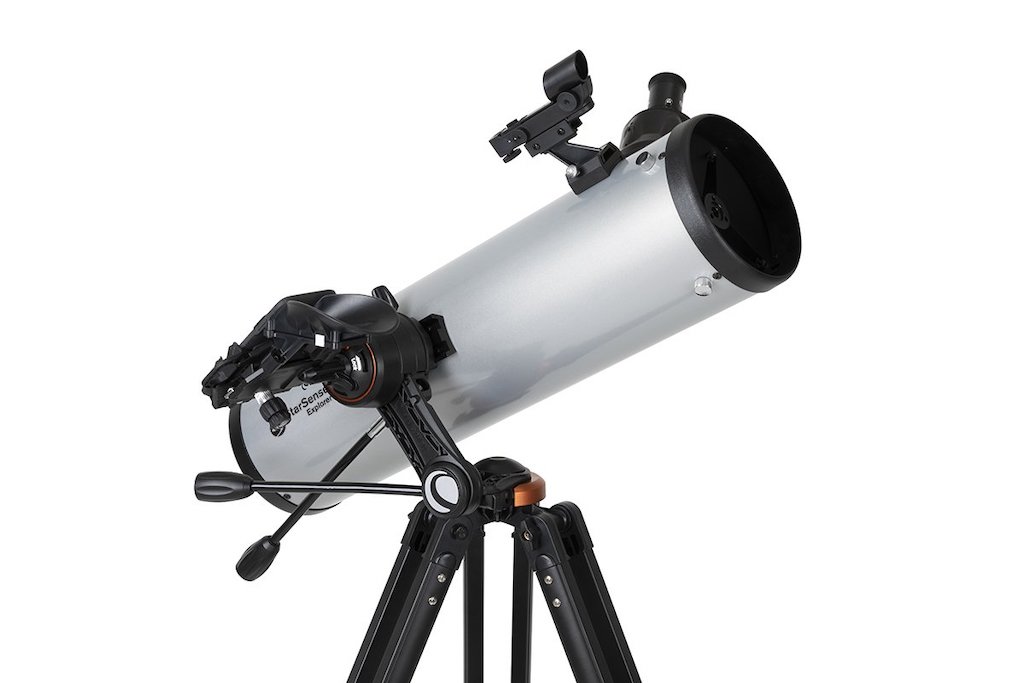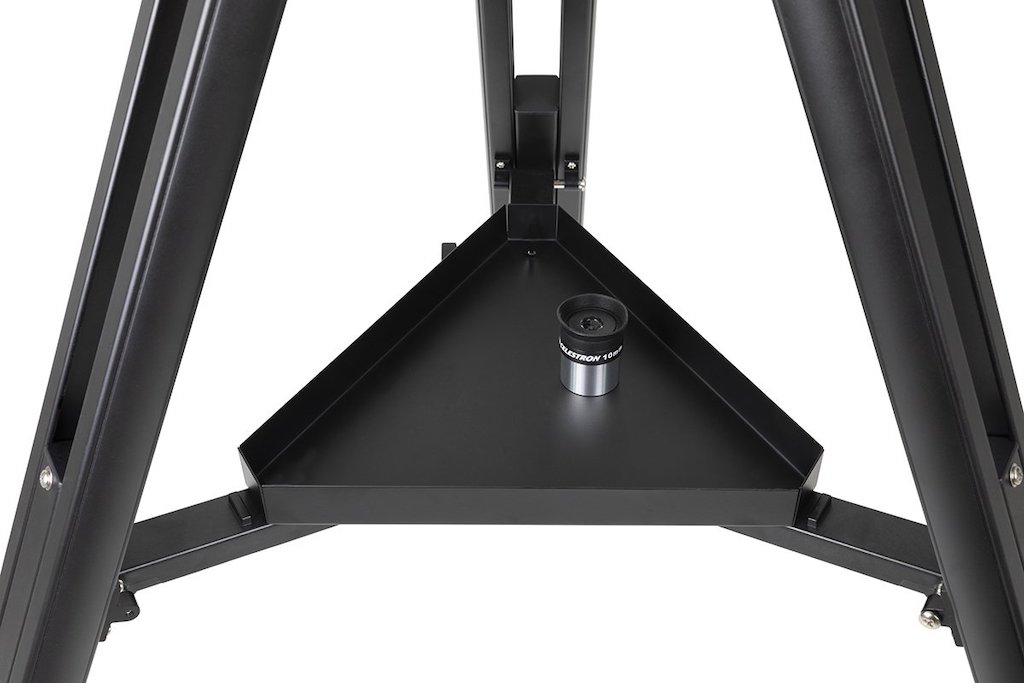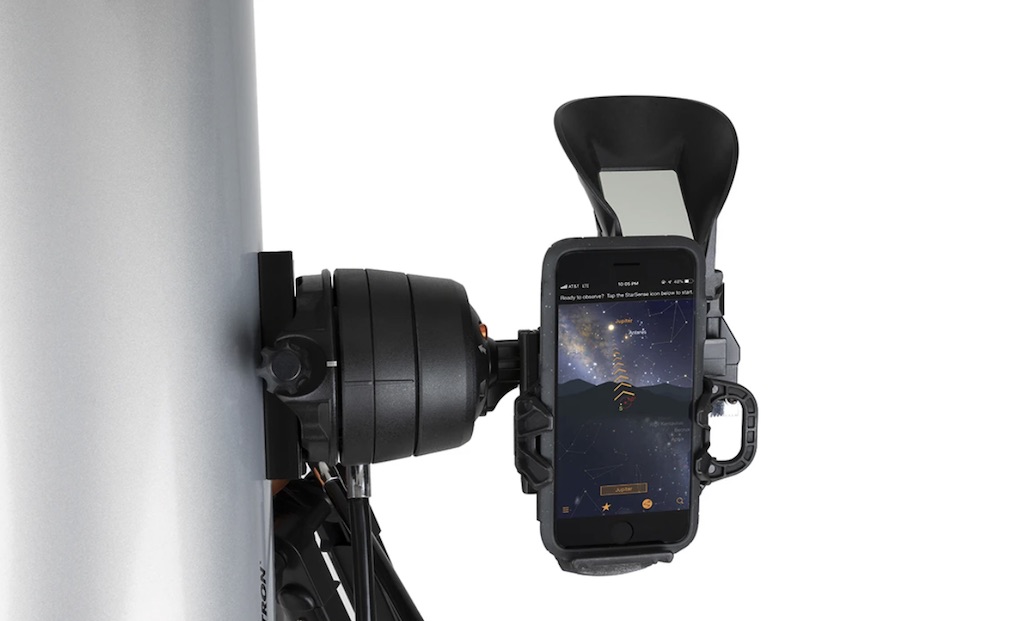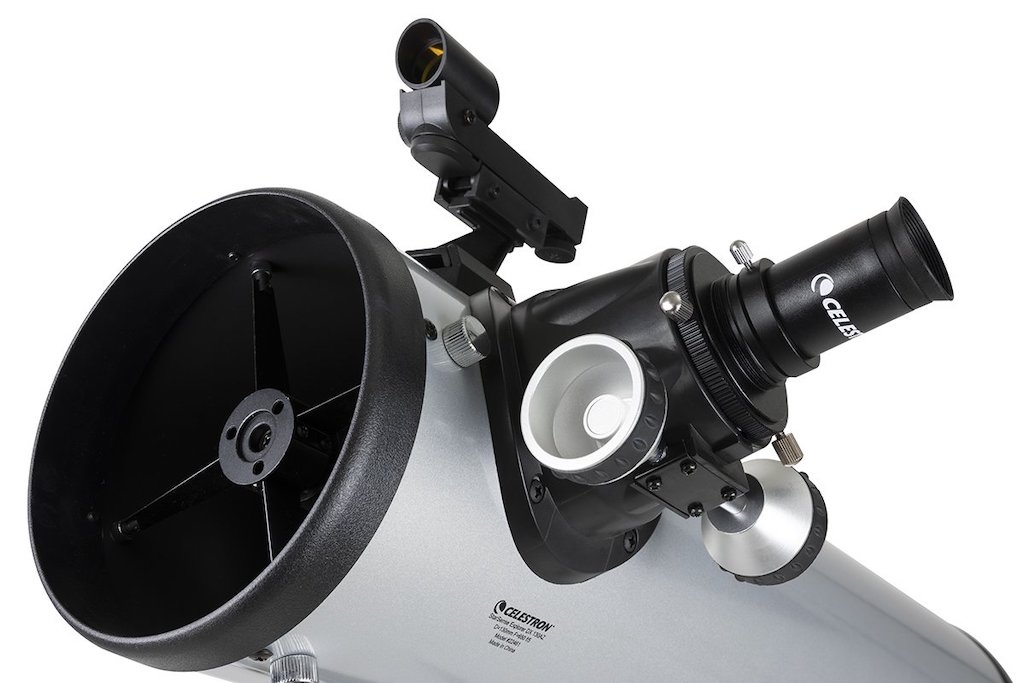Space Verdict
The Celestron StarSense Explorer DX 130 is an exquisite telescope for the beginner — whether they're wishing to get some assistance with navigating the night sky with the downloadable StarSense App or simply content with using the red-dot finder for star-hopping. The telescope is fully equipped, supplied with everything the skywatcher needs for a successful observing session under the stars but would benefit from additional high-powered eyepieces to get more detailed views of the planets. Basic astrophotography can be achieved with this instrument.
Pros
- +
Great price
- +
Crisp and clear views
- +
Superb StarSense App
- +
Very user friendly
- +
Aperture is a good size
- +
Set up is highly portable
Cons
- -
Undriven mount
- -
Limited to basic astrophotography
- -
Supplied eyepieces offer low-powered views only
Why you can trust Space.com
Optical design: Newtonian reflector
Aperture: 5.11” (130 mm)
Focal length: 25.59” (650 mm)
Focal ratio: f/5
Highest useful magnification: 307x
Lowest useful magnification: 19x
Total kit weight: 18 lbs. (8.16 kg)
Mount type: Alt-azimuth
The Celestron StarSense Explorer DX 130AZ truly unveils the wonders of the night sky, even with the most rudimentary knowledge and experience. It's the largest of Celestron's StarSense Explorer range of telescopes, of which includes the StarSense Explorer DX 80AZ, Celestron StarSense Explorer DX 102AZ and StarSense Explorer DX 114AZ.
With a range of apertures, the StarSense Explorer line up offers telescopes with a selection of affordable price points — with eyepieces, star diagonals, mounts, tripods, accessory trays and a smartphone dock included in the budget.
Celestron StarSense Explorer DX 130AZ review: Design
- Can be used with or without the app
- Good quality optical tube and mount
- Only takes 15 minutes to assemble

The Celestron StarSense Explorer DX 130AZ is a 130-mm (5.1-inch) Newtonian reflector. Given its focal ratio of F/5 and focal length of 650 mm, it's a fast telescope that's suited to low-power viewing of celestial objects. The telescope tube itself attaches to an alt-azimuth mount with dual-axis slow-motion controls.
The optical tube and mount are of a good quality. One especially nice point is how lightweight and portable this system is, allowing the astronomer to easily move around with the entire assembly with no problem.
The telescope itself is moved manually, either by pushing the telescope tube with your hand or by using the slow-motion control knobs for fine adjustments. Building the instrument is simple and straightforward, especially when following the included instructions. Overall, the process took around 15 minutes.
The next step in the process is downloading the StarSense App to your phone, which is suitable for iPhone and Android users. It should be noted that the telescope can be used without a phone or indeed, the app — but as you’ll see later in this review, this is where the telescope really excels for the novice observer.
As the Celestron StarSense Explorer DX 130AZ is a Newtonian telescope, it's very important to collimate the mirrors; this is quite easy to achieve following the included instructions. We cannot stress how important this is if you really want to get the most out of the DX 130AZ — it will make a significant difference to your enjoyment of the telescope.

The telescope comes with two eyepieces — a 25 mm and a 10 mm, offering powers of 26x and 65x, which are suitable for low power wide-field observing. If you wish to use higher powers, we recommend purchasing a good quality Barlow lens. To see a good amount of detail on the planets, you will need magnifications of at least 150x — well above what the included eyepieces offer.
Once the telescope is assembled you are ready to download the StarSense App. The vast majority of popular phones support operation of the app so it's pretty unlikely you’ll come up against a compatibility issue. For the purpose of this review, we used a Samsung Galaxy S10+ phone for operation of the app — no issues were encountered.
The app itself is very easy to use with an attractive graphical interface and easy to understand commands. Once downloaded, you can then plug your phone into the docking station on the telescope and adjust so your phone camera is pointing correctly at the docking station mirror. Many different objects are included within the app such as planets, stars, nebulas and galaxies — enough to keep astronomers busy for a very long time!
Once you are ready and have a clear night you are ready to attempt using the telescope under the night sky. I would advise playing around during the daytime however to get a feel for everything — its much easier to resolve initial problems during the daytime than outside in the cold and dark.
Once set up outside, it's time to align the telescope to the night sky. The alignment process is quite clever and straightforward. The app plate solves the image it sees from your phone camera to identify where the telescope is pointed and works quickly and accurately.
The fact that technology such as this is now available in beginner telescopes is impressive and completely takes away the countless hours one would otherwise spend star hopping to different objects (a process that takes far more time and patience!)
Celestron StarSense Explorer DX 130AZ review: First light and functionality
- Easy to use for navigation
- Sadly doesn't include high-powered eyepieces
- Views are good — clear, crisp and contrasty

Once set-up and aligned you’re ready to begin observing. This where the Celestron Explorer DX 130AZ really does impress. Our first target for the telescope was Mars shining brightly in the south east.
The StarSense facility instructs you to move in a specific direction with the telescope and as you push the tube, drawing closer to the object, the app slowly zooms in — that's your cue to start using the slow-motion controls. Once centered in the bullseye graphic, you are ready to view the target object through the eyepiece. We were impressed to see Mars dazzling near the center of the field of view during our observations.
We moved to a variety of different objects from galaxies to nebulas, all of which were located without a problem with the StarSense Explorer DX 130AZ and always within the low power field of view.
The Andromeda Galaxy (Messier 31), Triangulum Galaxy (Messier 33), Orion Nebula (Messier 42), Bode's Galaxy (Messier 81) and the Cigar Galaxy (Messier 82) were all observed through an impressively sharp and contrasty view. Afterward we slewed back to move back to Mars again and pushed the optics to higher powers using a Barlow lens (not included). At around 150x, Mars appeared sharp with the familiar albedo markings visible. Even the planet's tiny south polar cap could be glimpsed. Meanwhile, the moon was shown to have impressive detail with myriad craters and mountains.

Star testing the telescope at higher powers revealed well-corrected optics, and stars focused nicely into tiny airy disks as you would expect from a good quality telescope. It's a shame much higher-powered eyepieces or Barlow isn’t included as you need a substantial magnification to see planetary details: the supplied eyepieces don't offer this.
We decided to try operating the telescope without our phone and the StarSense App, which we found to be hassle-free. The telescope includes a small red-dot finder, which works well and is able to pick out some of the fainter stars for star-hopping.
It should be noted that it's best to align the finder during the day and on terrestrial objects to save fiddling around in the dark. Even as a simple manual telescope, the Explorer DX 130AZ works nicely. Of course, then you have to locate objects "the hard way" but the motions in moving the telescope are smooth and the slow-motion controls work smoothly enough for centering and keeping objects within the field of view.
While this reflector is a fine telescope for visual observing, it is not really suited to astrophotography. Since the mount is undriven long exposure work is impossible. You can of course take simple afocal images by holding a phone to the eyepiece, and the moon is a great target for this purpose.
Should you buy the Celestron StarSense DX 130AZ?
Overall, the Celestron StarSense Explorer DX 130AZ is a great telescope for the beginner skywatcher. It has an affordable price tag: you get a very capable system for your money. It's also extremely user-friendly, we discovered a youngster at the age of eight years old was able to start getting to grips with it.
No telescope is perfect, and this is no exception. We would have loved to have seen a higher power eyepiece or Barlow lens included in the package to allow higher power views of the planets (essential if you wish to see details on them).
Another point worth mentioning is that the telescope must be collimated to perform properly: this isn’t the simplest of tasks for the beginner, especially with a Newtonian. That said, the small size of this instrument makes the process simpler than on larger telescopes where you are constantly moving between collimation screws and an eyepiece.
The StarSense Explorer DX 130AZ is a great choice for a first telescope or for those just starting out. Its great user-friendliness and capable StarSense App make this telescope an impressively powerful tool that will offer many hours of observing pleasure.
If this product isn't for you
This great telescope is featured in our best telescopes for beginners guide, along with its highly-recommended cousin — the Celestron StarSense Explorer LT 114AZ — featured as one of our best telescopes for 2021.
However, if you're looking for something that offers the same observing clout with an 130mm aperture — and with a range of accessories — then the Celestron Astro Fi 130 is a good choice, offering a bit more of a leg-up in terms of smartphone astrophotography and a more sophisticated way of touring the night sky.
Join our Space Forums to keep talking space on the latest missions, night sky and more! And if you have a news tip, correction or comment, let us know at: community@space.com.
Damian A. Peach FRAS is a British amateur astronomer, astrophotographer, lecturer and author. Best known for his photographs of a wide variety of astronomical objects. His career in the field spans over thirty years. Peach's passion for Astronomy first began in 1988 inspired by books in his school library. Later he joined the British Astronomical Association (BAA) in 1996 and since then has contributed large amounts of observations to the various observing sections and also written and co-authored many papers in the organization's journal. He was awarded the organization's prestigious Merlin Medal in 2006. The same year he was also awarded the Association of Lunar and Planetary Observers (ALPO) Walter H. Haas award for his contributions. Peach has provided astronomical images for magazines and books throughout his career. His images have been featured in Astronomy Magazine, Sky & Telescope, Astronomy Now & The Sky at Night. He has also authored articles on astrophotography for these magazines. Peach has also been a co-author on several professional scientific papers on planetary astronomy, especially regarding work on Mars and Jupiter. He was one of only a few amateur astronomers to have work featured as part of the national Explorers of the Universe exhibition at the Royal Albert Hall in 2007. His work has also appeared at the Edinburgh Science Festival, and The Royal Greenwich Observatory. Peach's work has also been used by NASA and ESA to illustrate what ground-based telescopes can achieve in photographing the planets, and the support they can provide to professional space probe missions.











